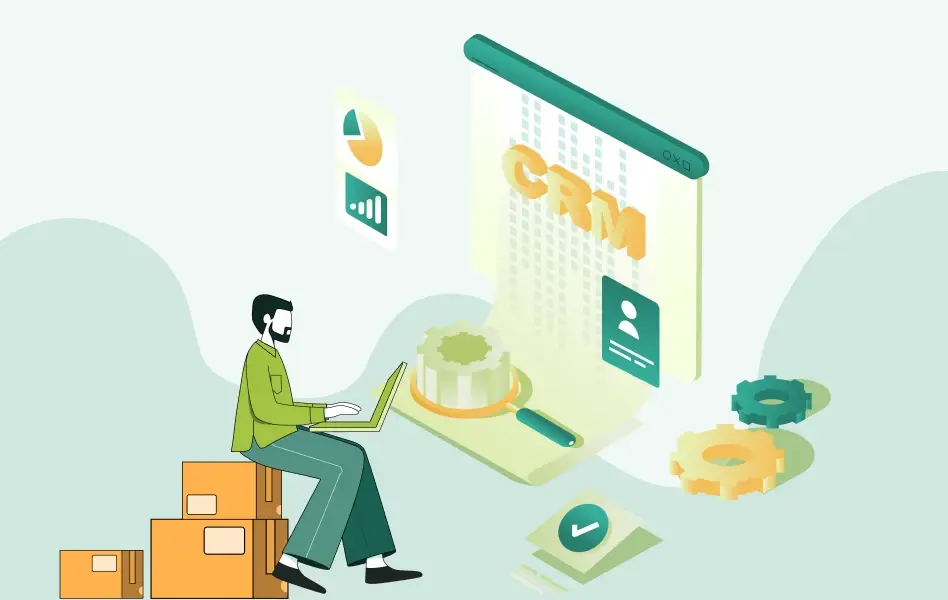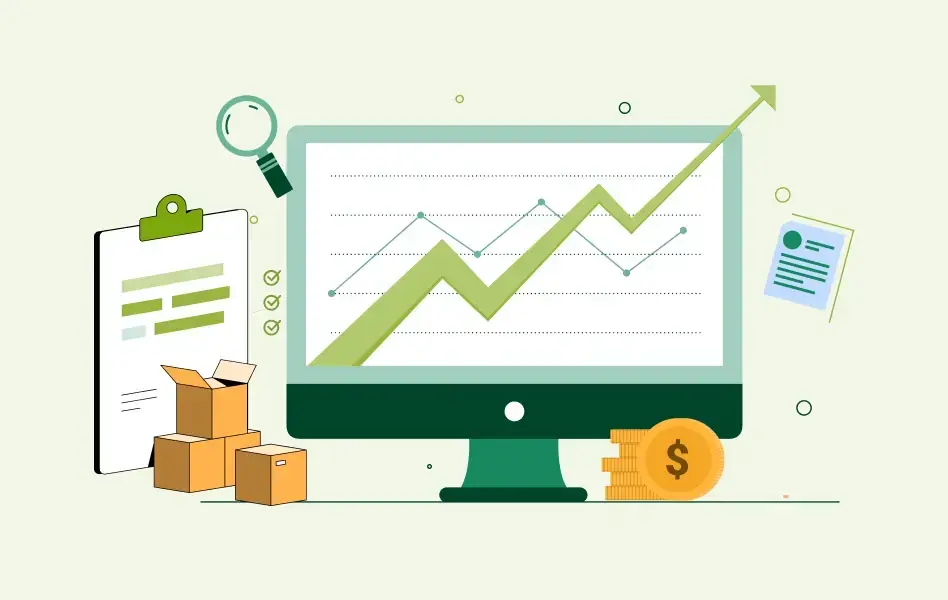Contents
Have you ever sent out a quote to a potential client and then heard nothing? It’s like shouting into the void, right? You put in the effort to craft the perfect proposal, only to be met with radio silence. We’ve all been there. The good news is that a perfectly crafted process can turn the tide in your favor: the follow-up email.
Did you know that following up with web leads within one minute can boost your chances of conversion by a whopping 391%? That’s not just a number; it’s a game-changer. This stat highlights just how crucial timely follow-ups are in the sales process. So, the next time you’re tempted to wait it out, remember—quick action can make all the difference.
Imagine this: You’ve just sent a quote for a big project that could significantly boost your business. You’re excited, hopeful, and maybe even a bit nervous. Days pass, and there’s no response. You start to wonder if they even received it. This is where a well-timed, well-crafted follow-up email can make all the difference. It shows your potential client that you’re proactive, professional, and genuinely interested in their business.
But how do you craft the perfect follow-up email? How long should you wait before sending it? What should you say to keep the conversation going without coming off as pushy? Don’t worry, we’ve got you covered. Let’s dive into the art of follow-up emails and discover how you can turn silence into a signed deal.
How Long to Wait Before Following Up?
When it comes to follow-up emails, timing is everything. You don’t want to seem overly eager, but you also don’t want to wait so long that the prospect forgets about you. Finding the sweet spot can be tricky, but it’s crucial for keeping potential deals alive and showing your professionalism. Almost 44% of salespeople give up after just one follow-up call. But here’s the kicker: one follow-up call usually isn’t enough to seal the deal.
Let’s break down the factors that affect the timing of your follow-up and find that perfect moment to hit send.
Factors affecting the timing of a response
- The urgency of the client’s needs:
- If the client expressed an urgent need or a tight deadline, don’t keep them waiting. A quicker follow-up shows that you’re attentive and ready to meet their needs.
- Example 1: If you’ve sent a proposal to a potential client in the tech industry who mentioned they need a solution by the end of the week, waiting more than 24-48 hours to follow up could risk losing their interest. In this case, a prompt follow-up within a day shows you understand their urgency and are ready to act quickly.
- The complexity of the quotation:
- A detailed, complex quote may require more time for the client to review. In such cases, a slightly longer wait time before following up can be more appropriate.
- Example: Suppose you’ve provided a detailed proposal with various custom options for a construction project. The client will likely need more time to review and discuss the details with their team. In this case, waiting a week before following up could be more appropriate, allowing them ample time to go through the complexities of the offer.
- Industry standards and client expectations:
- Different industries have different expectations for follow-ups. In fast-paced sectors, a quick follow-up might be expected, while in others, a more patient approach might be appreciated.
- Example 2: If you’re working in the legal industry where decisions are often made more slowly and deliberately, a follow-up after a week might be more in line with industry norms. Clients here expect thoroughness, and a patient follow-up approach aligns with their decision-making process.
Optimal waiting period before sending the first follow-up email
So, how long should you actually wait? Here’s a guideline that balances patience with promptness.
3 Business days to one week:
- This is generally a good rule of thumb. Waiting three business days gives the client enough time to review your quote without feeling pressured. If you haven’t heard back after a week, it’s definitely time to check in.
Picture this: You’ve just sent out a quote for a project that could be a game-changer for your business. You’re excited, maybe a bit anxious, and you know the clock is ticking. Waiting those three to five days can feel like forever, but it’s important to give the client enough space to make a decision. When you do follow up, you’re not just nudging them along; you’re showing that you’re organized, professional, and genuinely interested in their business.
Pro tip: If you mentioned a specific timeline for a decision in your initial email or quote, align your follow-up accordingly. If you said you’d check back in a week, then make sure you do exactly that. Consistency builds trust.
Remember, the goal of your follow-up is to remind the client of your proposal and offer additional assistance without coming off as desperate or pushy. It’s all about striking the right balance.
To Learn More, also read: High Point Market Email Marketing: Free Templates to Get Started.
Now that you’ve nailed the timing, let’s move on to crafting the perfect follow-up email that will keep your proposal at the top of their mind without annoying them. Ready to dive in? Let’s go!
Top 3 Essential Elements in Follow-Up Emails
Follow-up emails are crucial to your sales strategy, often determining whether you close a deal or lose a prospect. For these emails to be effective, they must include specific key elements, which also help boost sales revenue. According to the DMA, personalized emails enhance sales and revenue, accounting for 58% of total revenue through segmented and targeted campaigns. Let’s explore what makes a follow-up email truly exceptional.
1. Killer subject lines to grab attention
Imagine this: your potential client opens their inbox and sees dozens of unread emails. How do you make sure yours stands out? The answer lies in crafting a killer subject line. It’s the first thing they see, and it can make or break your email’s chances of being opened.
Think of subject lines like “Did you receive our quote?” or “Quick question about your proposal.” These are direct, relevant, and create a sense of urgency or curiosity. The goal is to entice the recipient to open your email and read on.
2. Clear and compelling call to action(CTA)
Once your email is opened, you need to guide the recipient on what to do next. This is where a clear and compelling Call to Action (CTA) comes into play. Whether it’s scheduling a call, asking for feedback, or confirming receipt, your CTA should be straightforward and easy to follow.
For instance, you might say, “Can we schedule a quick call to discuss this further?” or “Please confirm if you received our quote.” Clear CTAs help eliminate any confusion about what the recipient should do next, making it easier for them to take action.
3. Professional and friendly tone
Striking the right balance between professionalism and friendliness is key. You want to come across as approachable and helpful, but also as a competent professional. Use a conversational tone, but avoid being overly casual. Think of your emails as if you’re having a polite yet friendly chat with a client.
Phrases like “I hope this email finds you well” or “I’m here to help with any questions you may have” can set a positive tone and make your email more engaging.
Tips for Enhancing Follow-Up Emails
Follow-up emails are more than just a polite nudge—they’re an essential part of your sales strategy. In fact, 74% of marketers say that targeted messages and personalized emails improve customer engagement rates. This shows just how important it is to get your follow-up emails right. To make your follow-ups effective, it’s important to fine-tune your approach. Here are some tips to help you craft follow-up emails that get results.
1. Respect email etiquette and branding
Maintaining proper email etiquette is crucial. This includes using professional language, being polite, and keeping your emails free from typos and errors. Also, ensure your emails reflect your company’s branding. This consistency helps build trust and recognition.
2. Include comprehensive contact details in the email footer
Always include your full contact details in the email footer. This makes it easy for the recipient to reach you if they have questions or need further information. Include your name, position, phone number, email address, and any relevant social media links or company website.
3. Sound human and personalize emails
No one likes receiving emails that sound like they were generated by a robot. Make your emails sound human by personalizing them. Use the recipient’s name, reference past conversations, and tailor the content to their specific needs. Personalization shows that you’ve put thought into your communication and are genuinely interested in helping them.
4. Optimize email templates based on feedback
Your follow-up emails should be dynamic, and continually evolving based on feedback and results. If a specific template isn’t achieving the desired response, make adjustments to it. Pay attention to what works and what doesn’t, and continuously optimize your emails to improve their effectiveness.
Tracking Your Follow-Up Emails
Keeping track of your follow-up emails is crucial to understanding their effectiveness and improving your strategy. By using email tracking tools, you can gain valuable insights into how your recipients are interacting with your emails, helping you to fine-tune your approach for better results. Let’s explore the benefits of tracking your follow-up emails and the kind of insights you can gain.
- Benefits of email-tracking
-
-
- Email-tracking can be a game-changer for your follow-up strategy. It allows you to see whether your emails are being opened and how recipients are interacting with them. This information can help you tailor your follow-up approach and improve your chances of closing deals.
-
- Insights provided by tracking tools
-
- Tracking tools can provide valuable insights such as open rates, click-through rates, and response times. These metrics help you understand how effective your emails are and identify areas for improvement. For example, if you notice that emails sent at a certain time of day have higher open rates, you can adjust your sending schedule accordingly.
Avoid Being Pushy
In the world of follow-up emails, there’s a fine line between being persistent and being pushy. Striking the right balance is crucial to maintaining a positive relationship with potential clients. Here’s how to avoid coming off as too aggressive while still keeping the conversation alive.
- Know when to stop follow-ups
-
-
- It’s important to recognize when to stop following up. If you’ve sent several follow-up emails without a response, it might be time to take a step back. Being overly persistent can annoy potential clients and damage your professional relationship.
-
- Express appreciation and commitment to providing excellent service
-
- Even if a deal doesn’t go through, always express your appreciation for the recipient’s time and consideration. Let them know you’re committed to providing excellent service and are available for any future needs. This leaves the door open for future opportunities and maintains a positive impression.
By incorporating these elements and tips into your follow-up emails, you can enhance your communication strategy, build stronger client relationships, and increase your chances of closing deals.
Email Follow-Up Templates
Crafting the perfect follow-up email can significantly impact your chances of closing a deal. Did you know that 96% of organizations believe that email personalization can improve email marketing performance? This highlights how crucial it is to personalize your follow-up emails. Here are some effective templates to guide you in creating impactful follow-up emails.
1. Template: confirmation of receipt
Email subject line: Did you receive our quote?
Body:
Hi [Contact Name],
I hope this email finds you well. I wanted to follow up and confirm that you received the quote I sent on [date]. I’m here to answer any questions you might have and discuss any details further.
Please let me know if there’s anything specific you’d like to discuss or if you need additional information.
Looking forward to your response.
Best,
[Your Name]
When to send: 3 business days to one week after the initial email.
2. Template: asking for questions
Email subject lines: Did we explain everything well? / Do you have questions?
Body:
Hi [Contact Name],
I hope you’re doing well. I wanted to check in and see if you had any questions about the quote we sent on [date]. We’re here to help and would love to clarify any details or discuss any concerns you might have.
Feel free to reach out if there’s anything you’re unsure about or want to set up a time to discuss this further.
Best regards,
[Your Name]
When to send: 2-3 weeks after the quotation is sent.
3. Template: expiration reminder
Email subject lines: Friendly reminder: Your offer will expire
Body:
Hi [Contact Name],
Just a friendly reminder that the quote we provided on [date] is set to expire soon on [expiration date]. If you need more time or have any questions, please let me know, and we can discuss extending the offer.
We’re excited about the opportunity to work with you and are here to assist with any information you need to make a decision.
Best,
[Your Name]
When to send: Close to the expiration date, 3 days to one week in advance.
4. Template: proposal accepted
Email subject line: Thank you! One last question before we start
Body:
Hi [Contact Name],
Thank you for accepting our proposal! We’re thrilled to begin this partnership. Before we get started, I wanted to ask if you need any final details or questions addressed.
Your feedback is valuable to us, and we’re here to ensure everything goes smoothly as we move forward.
Thanks again,
[Your Name]
When to send: Immediately after the proposal is accepted.
5. Template: proposal rejected
Email subject line: Thank you!
Body:
Hi [Contact Name],
Thank you for considering our proposal. While I’m sorry to hear that you’ve decided to go in a different direction, I appreciate the opportunity to discuss your needs. If possible, could you share any feedback on why our proposal wasn’t a fit? This will help us improve for future opportunities.
Please don’t hesitate to reach out if there’s anything we can assist with in the future.
Best regards, [Your Name]
When to send: The same day the proposal is rejected.
These templates are designed to keep your communications professional, friendly, and effective. Remember, the key is to be polite, clear, and persistent without being pushy.
Conclusion
Mastering the art of follow-up emails can truly make a difference in closing deals. Remember, timing is everything. Waiting 3 business days to one week before following up shows professionalism without seeming too eager. Always personalize your emails by addressing the recipient by name and referencing specific details from your previous conversations. Keep your emails concise and to the point—busy professionals will appreciate your brevity and clarity.
Crafting engaging subject lines is key to grabbing attention and getting your email opened. Make sure to include a clear call to action, guiding the recipient on what to do next. And, of course, maintain a balance between professionalism and friendliness to make your emails both approachable and engaging.
Strategic and thoughtful communication is essential. When you follow up with care and consideration, you build trust and show your commitment to providing excellent service. Even if an immediate deal doesn’t work out, thoughtful communication keeps the door open for future opportunities.
Remember, your follow-up emails are a reflection of your business. Make them count by being strategic, respectful, and attentive.
Ready to take your follow-up game to the next level? WizCommerce is here to help! Our tools and solutions can streamline your sales process, making follow-ups easier and more effective. Connect with a WizCommerce expert today and book a demo to see how we can transform your business operations!











































































































